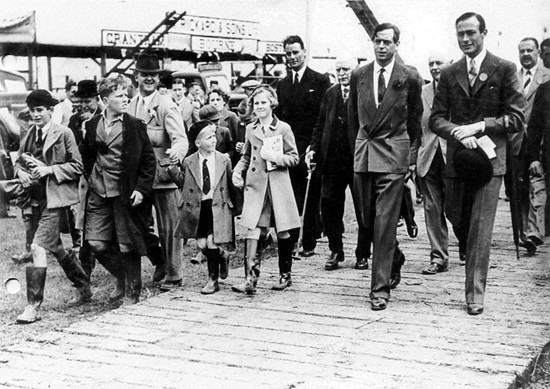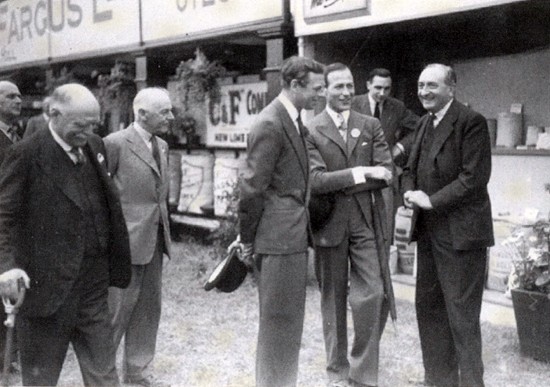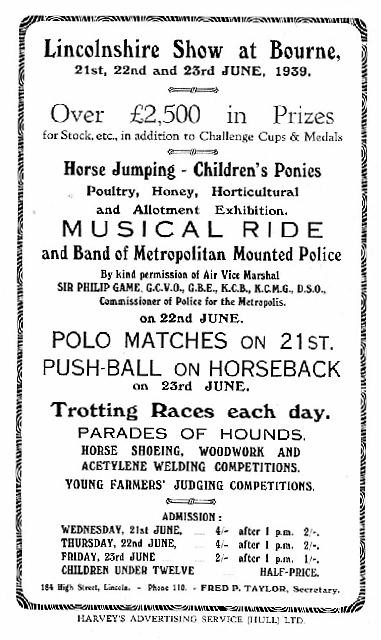|
The Lincolnshire
Agricultural Show
The only time in its long history that the Lincolnshire Agricultural Show visited Bourne was in the summer of 1939, shortly before the outbreak of the Second World War. It was a particularly auspicious occasion because the guest of honour on the first day was Prince George, the Duke of Kent, the king's younger brother, and so it turned out to be a royal occasion. The site chosen for the event was alongside the A15 near Morton where 57 acres were brought into use for the massive array of stands, animal pens, marquees and car parking and 150 bays of machinery, the largest number since 1930, but still leaving an extensive area of open ground, second only to that available at Lincoln. Entries in the stock classes were a record, totalling 712. Of this number, 42 were in a new class for Wessex saddleback pigs but even without this class, the entry would still have been higher than that for the three preceding shows at Scunthorpe, Spalding and Louth respectively. There was also a slight increase in the Lincoln Red Shorthorn entries and although the number of sheep were slightly down on the previous year, both pig and horse classes were better supported. Shire horses and poultry were also well represented and there were excellent entries for allotment and garden produce. The show was held over three days, Wednesday, Thursday and Friday the 21st, 22nd and 23rd of June and the Duke was scheduled to visit on the first day. He arrived by plane at RAF Wittering, accompanied by his equerry, Lord Herbert, and was met by the Marquess of Exeter, the Earl of Ancaster, president of the Lincolnshire Agricultural Society, Lord Willoughby de Ereseby, M P for Rutland and Stamford [the constituency which included Bourne] and Wing Commander D V Carnegie. The Duke motored through Stamford to Bourne with hundreds of people lining the route to see him pass and as he arrived at the showground in bright sunshine and drove down the main avenue, the band of the Metropolitan Police played the National Anthem amid cheers from a record crowd, many of them children who had been given the day off school to attend. The town was the smallest the show had ever visited and it had been gaily decorated with floral baskets hanging from the lamp posts, tubs of flowers along the streets, flags, banners and bunting festooned from buildings and across the roadways and special floodlighting effects along the riverside. On reaching the members' pavilion, the Duke was met by Lord Heneage, chairman of the Lincolnshire Agricultural Society, and Lord Ancaster presented some 20 officials and members of the committee who had organised the event. Afterwards, he inspected a guard of honour formed by 120 ex-servicemen from Bourne and then toured the showground. He stopped at several stands to talk to company representatives including Mr Eric Rickards, of Messrs T Rickard and Sons, the agricultural engineering and implement suppliers, Raymond Mays, who was representing his family firm of Mays Chemical Manure Company, fertiliser manufacturers, Mr Albert Wherry, of Wherry and Sons Ltd, corn and seed merchants, and Mr George Stafford, a basket maker of Burghley Street, whose employees were busy making baskets. There was also a War Office military display of two light tanks, Bren guns and other weapons, war being only a few months away.
The Duke had lunch in the stewards' pavilion and in the afternoon, watched the grand parade of animals in the main ring and presented the supreme cattle championship cup. He left the showground at 3 pm and returned to Wittering by the same route. Although Bourne was one of the principal centres for agriculture at that time, it was the first occasion that the show had been held there and the local organising committee raised more than £1,100 as a guarantee fund to ensure its success. The public attractions included a polo match, trotting races, scurry stakes, push ball on horseback and a musical ride by the Metropolitan Military Police. There were also parades of the Cottesmore and Belvoir Hounds and music by the Metropolitan Police Band. Other attractions included displays of horseshoeing, acetylene welding and practical beekeeping with exhibitions of honey, hives and appliances, and a big floral display in the horticultural tent. On the evening of the first day there was also a 20-ver cricket match between Bourne and Sleaford, the visitors winning by 19 runs. The visit by the Duke was among the last of his public engagements before the outbreak of the war when he joined the Royal Air Force and in 1942 he lost his life in a plane crash..
See also Other royal occasions
Go to: Main Index Villages Index
|
||||||


